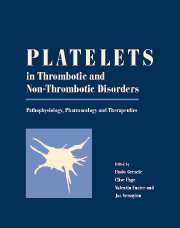Book contents
- Frontmatter
- Contents
- List of contributors
- Editors' preface
- PART I PHYSIOLOGY
- 1 History of platelets
- 2 Production of platelets
- 3 Morphology and ultrastructure of platelets
- 4 Platelet heterogeneity: physiology and pathological consequences
- 5 Platelet membrane proteins as adhesion receptors
- 6 Dynamics of the platelet cytoskeleton
- 7 Platelet organelles
- 8 Platelet receptors for thrombin
- 9 Platelet receptors: ADP
- 10 Platelet receptors: prostanoids
- 11 Platelet receptors: collagen
- 12 Platelet receptors: von Willebrand factor
- 13 Platelet receptors: fibrinogen
- 14 Platelet signalling: GTP-binding proteins
- 15 Platelet phospholipases A2
- 16 Roles of phospholipase C and phospholipase D in receptor-mediated platelet activation
- 17 Platelet signalling: calcium
- 18 Platelet signalling: protein kinase C
- 19 Platelet signalling: tyrosine kinases
- 20 Platelet signalling: cAMP and cGMP
- 21 Platelet adhesion
- 22 The platelet shape change
- 23 Aggregation
- 24 Amplification loops: release reaction
- 25 Amplification loops: thromboxane generation
- 26 Platelet procoagulant activities: the amplification loops between platelets and the plasmatic clotting system
- 27 Platelets and chemotaxis
- 28 Platelet–leukocyte interactions relevant to vascular damage and thrombosis
- 29 Vascular control of platelet function
- PART II METHODOLOGY
- PART III PATHOLOGY
- PART IV PHARMOLOGY
- PART V THERAPY
- Afterword: Platelets: a personal story
- Index
- Plate section
24 - Amplification loops: release reaction
from PART I - PHYSIOLOGY
Published online by Cambridge University Press: 10 May 2010
- Frontmatter
- Contents
- List of contributors
- Editors' preface
- PART I PHYSIOLOGY
- 1 History of platelets
- 2 Production of platelets
- 3 Morphology and ultrastructure of platelets
- 4 Platelet heterogeneity: physiology and pathological consequences
- 5 Platelet membrane proteins as adhesion receptors
- 6 Dynamics of the platelet cytoskeleton
- 7 Platelet organelles
- 8 Platelet receptors for thrombin
- 9 Platelet receptors: ADP
- 10 Platelet receptors: prostanoids
- 11 Platelet receptors: collagen
- 12 Platelet receptors: von Willebrand factor
- 13 Platelet receptors: fibrinogen
- 14 Platelet signalling: GTP-binding proteins
- 15 Platelet phospholipases A2
- 16 Roles of phospholipase C and phospholipase D in receptor-mediated platelet activation
- 17 Platelet signalling: calcium
- 18 Platelet signalling: protein kinase C
- 19 Platelet signalling: tyrosine kinases
- 20 Platelet signalling: cAMP and cGMP
- 21 Platelet adhesion
- 22 The platelet shape change
- 23 Aggregation
- 24 Amplification loops: release reaction
- 25 Amplification loops: thromboxane generation
- 26 Platelet procoagulant activities: the amplification loops between platelets and the plasmatic clotting system
- 27 Platelets and chemotaxis
- 28 Platelet–leukocyte interactions relevant to vascular damage and thrombosis
- 29 Vascular control of platelet function
- PART II METHODOLOGY
- PART III PATHOLOGY
- PART IV PHARMOLOGY
- PART V THERAPY
- Afterword: Platelets: a personal story
- Index
- Plate section
Summary
Introduction
As a consequence of vessel wall damage, circulating platelets adhere to subendothelial ligands, targeting them to the site of injury. Adhering platelets undergo a multitude of signalling events, which result in platelet activation and spreading. Whereas platelet spreading on collagen and binding of adhesive proteins facilitate subsequent recruitment of additional platelets from the circulation, the activation of platelets also leads to the controlled release of their contents. Thus, the local secretion of further agonists of platelet activation, via a signalling controlled exocytosis reaction, contributes to the rapid recruitment of circulating platelets to the injury site; secreted proteins also facilitate fibrin formation.
In a forming platelet aggregate, as a result of inside-out signalling, the platelet receptor for fibrinogen, i.e. GPIIb/IIIa, is assembled. The binding of fibrinogen to this receptor not only enables platelet cross-linking, but further contributes to the ongoing platelet activation via outside–in signaling. This highly localized enhancement of ongoing platelet activation leads to marked degranulation in a confined area. Thus, platelet aggregate formation occurs as the result of both platelet adhesion and localized secretion, leading to the formation of a platelet plug, in which large numbers of platelets are completely degranulated.
Platelet granules and exocytosis
Morphologically, three types of platelet granules can be released: dense core granules (δ-granules), α-granules and platelet lysosomes (λ-granules).
- Type
- Chapter
- Information
- Platelets in Thrombotic and Non-Thrombotic DisordersPathophysiology, Pharmacology and Therapeutics, pp. 357 - 368Publisher: Cambridge University PressPrint publication year: 2002
- 1
- Cited by

